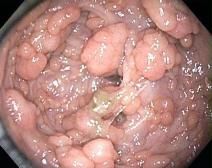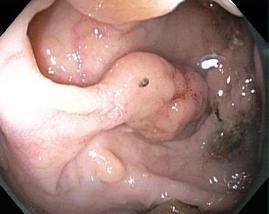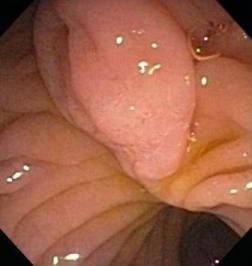- Clinical Technology
- Adult Immunization
- Hepatology
- Pediatric Immunization
- Screening
- Psychiatry
- Allergy
- Women's Health
- Cardiology
- Pediatrics
- Dermatology
- Endocrinology
- Pain Management
- Gastroenterology
- Infectious Disease
- Obesity Medicine
- Rheumatology
- Nephrology
- Neurology
- Pulmonology
A Young Man With Thousands of Colorectal Polyps: Anomalous and Benign? Or, Something Else?
Diagnostic colonoscopy revealed innumerable polyps carpeting the mucosa from the rectum to the cecum. Endoscopic findings and family history were most consistent with familial adenomatous polyposis.
A 26-year-old man presented to the emergency department with progressively worsening generalized fatigue and weakness that had been present for the past few months. Findings from the patient’s history and physical examination were unremarkable. A family history was notable for colon cancer in his father and grandfather when they were in their 40s. Laboratory studies revealed the following values, significant for iron deficiency anemia: hemoglobin, 8.8 g/dL; mean corpuscular volume, 72 fL; iron, 12 µg/dL; ferritin, 2.8 ng/mL; and total iron-binding capacity, 402 µg/dL.

Diagnostic colonoscopy revealed innumerable polyps carpeting the mucosa from the rectum to the cecum (Figure 1, left). Multiple polyps measured more than 1 cm and were on very large stalks (Figure 2, below, left). Upper endoscopy revealed small polyps in the proximal stomach and an ampullary adenoma (Figure 3, below, right). The constellation of endoscopic findings and family history were most consistent with familial adenomatous polyposis (FAP). Biopsy specimens from the colon and ampulla revealed adenomas with high-grade dysplasia, but there was no evidence of submucosal invasion.
The patient underwent blood transfusion, prophylactic total proctocolectomy with ileoanal J-pouch anastomosis, and ampullectomy. He was also educated on the importance of genetic screening for children he might have.


Discussion
FAP, an autosomal dominant disease caused by a mutation in the adenomatous polyposis coli (APC) gene, is characterized by hundreds to thousands of colorectal adenomatous polyps of various sizes.1 Patients with FAP are at increased risk for colorectal cancer; in 90% of persons with untreated FAP, colorectal cancer develops by age 45 years. Hence, early detection and surgical intervention are of utmost importance.
Patients with FAP typically present with symptoms such as a change in bowel habits, bright red blood in stool, abdominal pain, palpable abdominal masses, and weight loss.2 They can also present with extraintestinal manifestations such as osteomas, dental abnormalities, hypertrophy of the retinal pigment epithelium, desmoid tumors, and extracolonic cancers (eg, duodenal ampullary carcinoma, thyroid cancer, gastric carcinoma, childhood hepatoblastoma, and CNS tumors).1 Iron deficiency anemia is commonly present in patients with FAP and is secondary to occult and/or overt blood loss from polyps.
Our patient was fortunate enough to have sought medical attention and to have a diagnosis of FAP before colorectal cancer developed. He will continue to be monitored closely with routine surveillance endoscopy.
References:
References
1. Half E, Bercovich D, Rozen P. Familial adenomatous polyposis. Orphanet J Rare Dis. 2009;4:22.
2. Campbell WJ, Spence RA, Park TG. Familial adenomatous polyposis. Br J Surg. 1994;81:1722-1733.
